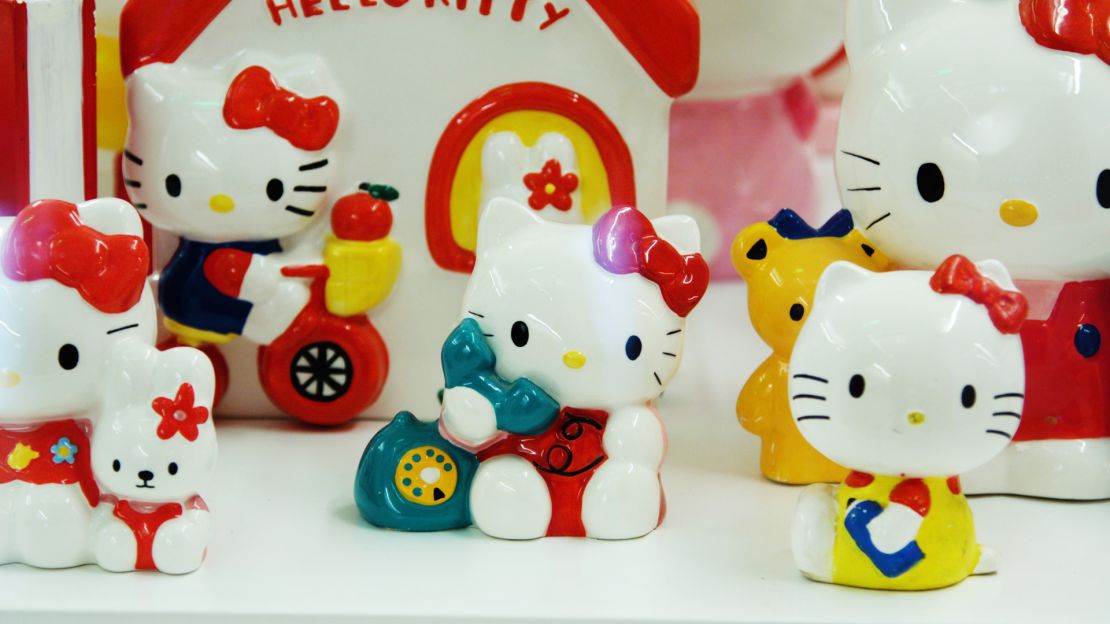Keroppi. Chococat. Gudetama. Aggretsuko.
No, those aren’t the names of hip nightclubs. They’re some of the famous characters developed by Japanese company Sanrio.
The most iconic face of the bunch, though, is Hello Kitty, the bow-sporting, mouth-lacking animal (who, Sanrio insists, is not actually a cat despite the name) whose visage has appeared everywhere from notebooks to sneakers to a high-speed train.
Making a brand
While some beloved cartoon characters around the world, such as Winnie the Pooh and the Moomins, got their start in kids’ books, Sanrio is different. The characters come first, content second.
Dave Marchi, the company’s vice president of brand management and marketing, spoke to CNN Travel in the company’s Los Angeles office – specifically in the Keroppi conference room.
“Sanrio is a character goods company first and foremost,” he explains, noting the company’s origins: its founder “Papa” Shintaro Tsuji, was selling small home goods such as rice bowls and chopsticks in the 1960s and came up with the idea of helping his products stand out by putting cute images on them.
The first of Tsuji’s logos was a little strawberry. And his gamble paid off: Sales immediately picked up.
It was Hello Kitty – who made her debut on a tiny plastic coin purse – who catapulted Tsuji’s cute little marketing idea into an international business.
But it’s a long way from adorable, mouthless Hello Kitty to Sanrio’s more contemporary creations.
“Aggretsuko,” is an animated series on Netflix that follows the namesake Sanrio character, a red panda, as she deals with her boring corporate accounting job in Tokyo by singing death-metal karaoke by night.
It is Sanrio’s first foray into TV, although the brand did make 30-second YouTube clips to introduce the Gudetama character. And it puts the brand into a whole new world of reimagining its future.

Hello Kitty in Tinseltown
While Shuji and the company are still based in Tokyo, the company’s North American business is run through the Los Angeles office.
In 2015, the company expanded into a larger space in El Segundo, not far from LAX airport.
The additional room gives employees more space to play around with ideas, but it also means that many Sanrio items are on display, creating an unofficial museum.
“We want to showcase all of the unique products that we have – through products, through product displays, through vintage displays,” Marchi says about the office design.
Throughout the space, employees have free rein to decorate their desks any way they want – some go hard on one specific favorite character, while others have a mix.
Though the office isn’t open to the public, the occasional superfan has been able to come and see the space in person – sometimes by collaborating with the brand on a project or by attending a private event.
Marchi adds that Sanrio is also considering allowing contest or auction winners exclusive one-off access to the premises.
The good news, though, is that CNN Travel was able to peek into the treasure chest, where Sanrio employees eat lunch on top of bright yellow Gudetama tables and walk past a mural of characters including Pochaco and Badtz-Maru.
Some staffers have even incorporated fan art into their workspace decor – one executive’s office has two original framed portraits of Hello Kitty done by artist Shepard Fairey, best known for his famous “Hope” Obama poster.
Encased in bulletproof glass, there’s also one of the two known original coin purses that made Hello Kitty a star; the other’s in a vault in Japan, and they each have their own security guard.
The East goes West

For many North Americans in their 20s and 30s, Sanrio was their first exposure to Japanese culture, particularly the idea of “kawaii” or “cuteness.”
Although Sanrio says it doesn’t create characters with target audiences in mind – after all, plenty of grownups still pack Hello Kitty fan events – Aggretsuko has particularly resonated with adults who identify with the character’s corporate workplace ennui, something that typical kids may not understand.
The red panda deals with sexism at work and also indulges in some distinctly non-kid-friendly activities like drinking alcohol and staying out late.
And fans often stay connected to their favorite character even as they get older.
“When a character is created, the designer imbues them with a personality and with a backstory,” Marchi explains.
“I don’t think we designed the characters to say, ‘Oh, we’re gonna design this and it’s gonna appeal to this kind of person.’ There are a lot of different things that people can react to, whether it’s the color of the design or the product, or the animal, or the character or the attitude.”
Even for fans who aren’t able to make a pilgrimage to Sanrio HQ, there are real-life brand extensions that make their characters come into 3-D. Taipei’s airport has a Hello Kitty lounge and Dubai a Hello Kitty nail salon.
L.A. is home to two permanent Hello Kitty cafes, and Hong Kong even has Hello Kitty dim sum.
Will the next move be an Aggretsuko-themed karaoke bar? We can only hope.

















